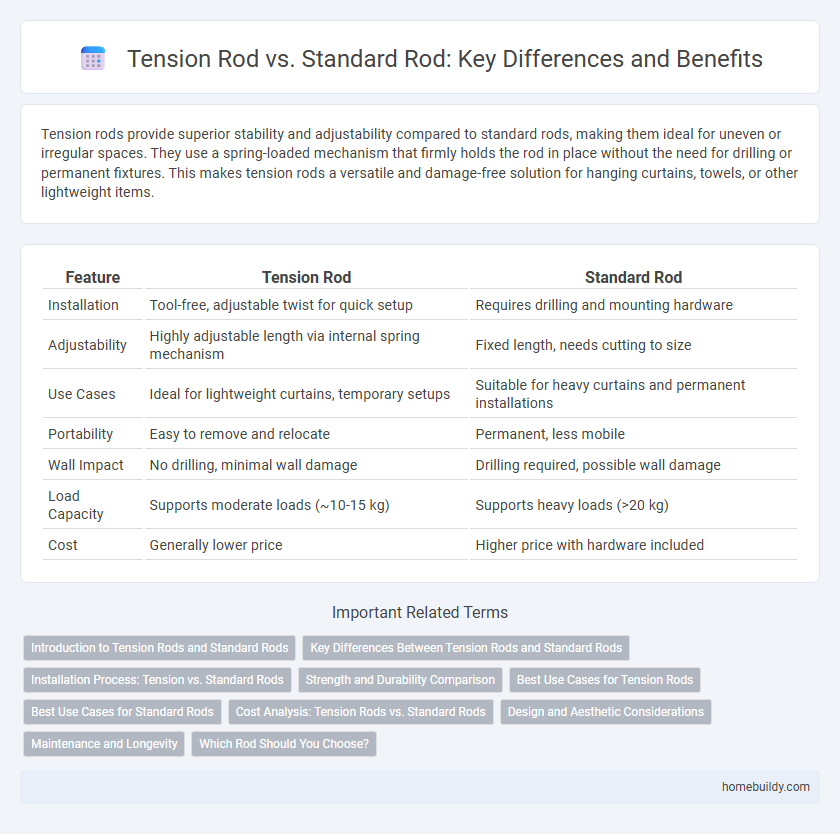Tension rods provide superior stability and adjustability compared to standard rods, making them ideal for uneven or irregular spaces. They use a spring-loaded mechanism that firmly holds the rod in place without the need for drilling or permanent fixtures. This makes tension rods a versatile and damage-free solution for hanging curtains, towels, or other lightweight items.
Table of Comparison
| Feature | Tension Rod | Standard Rod |
|---|---|---|
| Installation | Tool-free, adjustable twist for quick setup | Requires drilling and mounting hardware |
| Adjustability | Highly adjustable length via internal spring mechanism | Fixed length, needs cutting to size |
| Use Cases | Ideal for lightweight curtains, temporary setups | Suitable for heavy curtains and permanent installations |
| Portability | Easy to remove and relocate | Permanent, less mobile |
| Wall Impact | No drilling, minimal wall damage | Drilling required, possible wall damage |
| Load Capacity | Supports moderate loads (~10-15 kg) | Supports heavy loads (>20 kg) |
| Cost | Generally lower price | Higher price with hardware included |
Introduction to Tension Rods and Standard Rods
Tension rods are designed to withstand tensile forces by resisting stretching and maintaining structural stability, often used in applications requiring adjustable length and precise tension control. Standard rods typically endure compressive loads and bending stresses, lacking the adjustable tension feature critical for applications like curtain installation or scaffolding support. The key difference lies in tension rods' specialized material composition and construction methods that prioritize axial load resistance, ensuring enhanced durability and performance in tension-specific scenarios.
Key Differences Between Tension Rods and Standard Rods
Tension rods differ from standard rods primarily in their installation and function, as tension rods use spring tension to hold themselves in place without the need for screws or brackets. Standard rods typically require drilling and mounting hardware, which can cause permanent damage to walls. Tension rods offer greater versatility and ease of use, especially in rental spaces or temporary setups, while standard rods provide stronger support for heavier items.
Installation Process: Tension vs. Standard Rods
Tension rods install using a spring-loaded mechanism that allows for quick, tool-free mounting by simply twisting the rod to expand and secure it between two surfaces. Standard rods typically require brackets and screws, involving more time and effort for precise alignment and mounting. The tension rod's installation process is more efficient and less damaging to walls compared to the traditional drilled installation needed for standard rods.
Strength and Durability Comparison
Tension rods exhibit superior strength due to their ability to handle high tensile stress without bending or breaking, outperforming standard rods that primarily resist compression and bending forces. Engineered with materials such as high-tensile steel or reinforced alloys, tension rods offer enhanced durability, resisting corrosion and fatigue in demanding environments. This makes tension rods ideal for structural applications requiring long-lasting, reliable load-bearing components compared to conventional standard rods.
Best Use Cases for Tension Rods
Tension rods excel in applications requiring temporary or adjustable support, such as hanging curtains, creating room dividers, or stabilizing lightweight shelving without drilling into walls. Unlike standard rods, tension rods use friction and pressure to hold firmly between two surfaces, making them ideal for rental properties or flexible interior designs. Their ease of installation and removal caters to dynamic spaces where non-permanent fixtures are preferred.
Best Use Cases for Standard Rods
Standard rods are best suited for rigid applications requiring high load-bearing capacity and minimal flexibility, such as construction scaffolding and heavy machinery support. Their fixed length and robust design ensure stability under compressive and tensile forces, unlike tension rods which excel in adjustable tension settings. Standard rods provide reliable structural integrity in environments where precise tension adjustment is unnecessary.
Cost Analysis: Tension Rods vs. Standard Rods
Tension rods typically offer a more cost-effective solution compared to standard rods due to their simplified installation and reduced need for additional support hardware, lowering labor and material expenses. Standard rods often require extensive anchoring and precise alignment, increasing overall project costs and time. Evaluating the total expenditure, tension rods present a budget-friendly alternative for both residential and commercial applications without compromising structural integrity.
Design and Aesthetic Considerations
Tension rods feature a sleek, minimalist design that enhances modern interior aesthetics by eliminating bulky hardware typical of standard rods. Their streamlined structure provides a clean, unobtrusive appearance, making them ideal for contemporary spaces seeking both functionality and style. In contrast, standard rods often expose brackets and fixtures, which can detract from a room's visual harmony.
Maintenance and Longevity
Tension rods require less frequent maintenance compared to standard rods due to their adjustable nature, which allows for precise tension control that prevents sagging and wear. The durability of tension rods is enhanced by their ability to maintain consistent pressure, reducing the risk of bending or breaking over time. Standard rods often demand more upkeep because fixed-length designs can lead to uneven stress distribution, shortening their overall lifespan.
Which Rod Should You Choose?
Tension rods offer adjustable length and provide strong, temporary support by using spring pressure against surfaces, making them ideal for lightweight curtains or quick setups. Standard rods are fixed in length, typically sturdier, and better suited for heavy drapes or permanent installations where maximum durability is required. Choosing between the two depends on the weight of your curtains and whether you prioritize ease of installation or long-term stability.
tension rod vs standard rod Infographic

 homebuildy.com
homebuildy.com